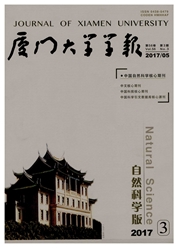

 中文摘要:
中文摘要:
以红树植物秋茄[Kandelia obovata(S.L.)Yong)]为研究试材,通过镉(Cd)和芘(Pyr)交互胁迫盆栽实验,研究秋茄体内酚类化合物对Cd-Pyr复合污染的响应,旨在探讨红树植物通过酚类化合物的调节耐受重金属和PAHs复合污染的作用机制.Cd胁迫含量为0,5,10,20,40mg/kg,Pyr胁迫含量为2,10,50mg/kg,二者交互胁迫.结果显示:Cd和Pyr胁迫下秋茄根、茎、叶合成大量的总酚、单宁和缩合单宁,含量均随着胁迫含量增大呈现上升趋势.各组织总酚、单宁和缩合单宁含量均表现出茎〉叶〉根.高含量Cd-Pyr复合胁迫下根、茎和叶的总酚、单宁和缩合单宁含量显著高于同一水平Cd胁迫组.根和叶中的总酚、单宁及缩合单宁的含量与相同器官中Cd的含量均呈显著正相关,可推测复合污染背景下总酚、单宁和缩合单宁参与了秋茄根和叶对Cd的螯合,增强了秋茄对Cd的耐性.
 英文摘要:
英文摘要:
In recent years,with the rapid urbanization and industrialization,many pollutants are discharged into mangrove ecosystems.Heavy metals and polycyclic aromatic hydrocarbons are particularly common in mangrove ecosystems.It is meaningful to study the response of mangrove plants to heavy metals-polycyclic aromatic hydrocarbons,which can evaluate correctly the tolerance mechanisms of mangrove plant under combined pollutions.To explore the tolerance mechanisms of phenolic compounds of mangrove plant under combined contaminations of heavy metals and polycyclic aromatic hydrocarbons,the responses of phenolic compounds in Kandelia obovata(S.L.)Yong under Cd and pyrene(Pyr)combined contamination were studied by apot experiment.The results showed that a large amount of total phenols,tannins,and condensed tannins were generated in the roots,stems,leaves of K.obovata under Cd/Pyr single stress and Cd and Pyr co-stress,and their contents increased with increasing stress.The order of the contents of total phenols,tannins,and condensed tannins in the plant tissues was as follows:stemleafroot.Additionally,the contents of total phenols,tannins,and condensed tannins in roots,stems,and leaves were significantly higher under high levels of co-stress than under single Cd-stress at the same level.There were significant positive correlations between the content of total phenol and Cd concentration in the root and leaf,between the content of tannin and Cd concentration in the root and leaf,and between the content of condensed tannin and Cd concentration in the root and leaf.Therefore,it was suggested that total phenols,tannins and condensed tannins may be involved in Cd tolerance in the roots and leaves of K.obovata under Cd-Pyr combined contamination.
 同期刊论文项目
同期刊论文项目
 同项目期刊论文
同项目期刊论文
 Xiangyu Xie, Bosen Weng, Bangping Cai, Yiran Dong, ChongLing Yan@. Effects of arbuscular mycorrhizal
Xiangyu Xie, Bosen Weng, Bangping Cai, Yiran Dong, ChongLing Yan@. Effects of arbuscular mycorrhizal Qiong Zhang. ChongLing Yan@. Jingchun Liu. Haoliang Lu. Hanhui Duan. Jingna Du. Wenyun Wang. Silicon
Qiong Zhang. ChongLing Yan@. Jingchun Liu. Haoliang Lu. Hanhui Duan. Jingna Du. Wenyun Wang. Silicon Xiangyu Xie, Dominik J. Weiss, Bosen Weng, Jingchun Liu, Haoliang Lu and ChongLing Yan@. The short-t
Xiangyu Xie, Dominik J. Weiss, Bosen Weng, Jingchun Liu, Haoliang Lu and ChongLing Yan@. The short-t Yu Fang, ChongLing Yan@, Jingna Du.Dependence of Phenanthrene Dissipation in Mangrove Sediment on th
Yu Fang, ChongLing Yan@, Jingna Du.Dependence of Phenanthrene Dissipation in Mangrove Sediment on th Juan Ye, Yan Chongling@, Jingchun Liu, Haoliang Lu, Tao Liu, Zengfeng Song. Effects of silicon on th
Juan Ye, Yan Chongling@, Jingchun Liu, Haoliang Lu, Tao Liu, Zengfeng Song. Effects of silicon on th Bosen Weng, Xiangyu Xie, Jinjin Yang, Jingchun Liu, Haoliang Lu, ChongLing Yan@ Research on the nitr
Bosen Weng, Xiangyu Xie, Jinjin Yang, Jingchun Liu, Haoliang Lu, ChongLing Yan@ Research on the nitr Effects of silicon on growth, root anatomy, radial oxygen loss (ROL) and Fe/Mn plaque of Aegiceras c
Effects of silicon on growth, root anatomy, radial oxygen loss (ROL) and Fe/Mn plaque of Aegiceras c Effects of arbuscular mycorrhizal inoculation and phosphorus supply on the growth and nutrient uptak
Effects of arbuscular mycorrhizal inoculation and phosphorus supply on the growth and nutrient uptak Silicon alleviates cadmium toxicity in Avicennia marina (Forsk.) Vierh. seedlings in relation to roo
Silicon alleviates cadmium toxicity in Avicennia marina (Forsk.) Vierh. seedlings in relation to roo Effect of enhanced reactive nitrogen availability on plant-sediment mediated degradation of polycycl
Effect of enhanced reactive nitrogen availability on plant-sediment mediated degradation of polycycl Arsenic Accumulationand Translocation in Mangrove (Aegiceras corniculatum L.) Grown inArsenic Contam
Arsenic Accumulationand Translocation in Mangrove (Aegiceras corniculatum L.) Grown inArsenic Contam Silicon Alleviation of Cadmium Toxicity in Mangrove (Avicennia marina) in Relation to Cadmium Compar
Silicon Alleviation of Cadmium Toxicity in Mangrove (Avicennia marina) in Relation to Cadmium Compar Dependence of Phenanthrene Dissipation in Mangrove Sediment on the Distance to Root Surface of Kande
Dependence of Phenanthrene Dissipation in Mangrove Sediment on the Distance to Root Surface of Kande Bosen Weng , Xiangyu Xie , Dominik J. Weiss, Jingchun Liu, Haoliang Lu , Chongling Yan@, Kandelia ob
Bosen Weng , Xiangyu Xie , Dominik J. Weiss, Jingchun Liu, Haoliang Lu , Chongling Yan@, Kandelia ob 期刊信息
期刊信息
